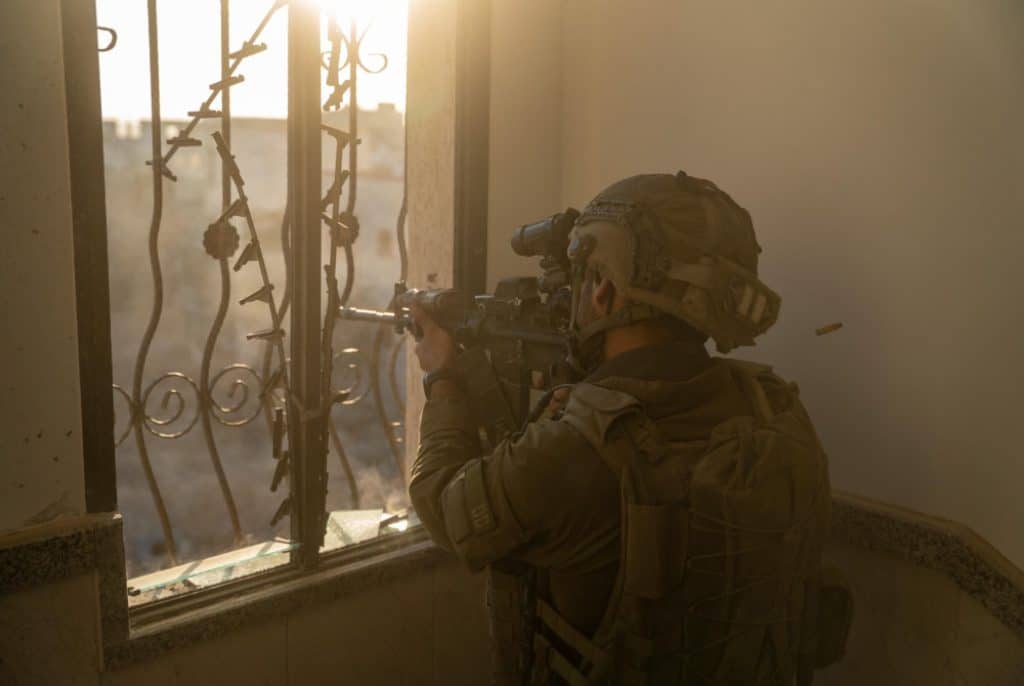
The Israel Defense Forces (IDF) said on November 8 that Israeli troops uncovered a Hezbollah “training center located approximately 200 meters from a UNIFIL [United Nations Interim Force in Lebanon] base.” The discovery of the site took place during a week in which Hezbollah continued to target Israel with around 100 rocket and drone attacks per day. Hezbollah also launched long-range rockets at central Israel on November 6 and November 8.
The Israeli military has been operating in southern Lebanon for five weeks. During this time, four IDF divisions have taken control of a number of villages close to the border and sought Hezbollah weapons and other sites used by the Iranian-backed terrorist group. The IDF continues to describe its operation in southern Lebanon as “limited, located, targeted ground raids.”
It is in this context that the IDF’s 9th Infantry (Oded) Brigade uncovered a Hezbollah training center near the UNIFIL base. The brigade has been operating in an unnamed area of southern Lebanon. The IDF frequently does not name areas where units operate due to operational security constraints. The 9th Brigade is usually under Israel’s 210th Division, which protects the Golan border with Syria. In September 2024, the 9th Brigade previously trained with Israel’s Golani Brigade for possible operations against Hezbollah or other enemies on the border.
The compound Israeli troops uncovered near the UNIFIL base “was used by terrorists for training, studying, and storing large quantities of weapons,” according to the IDF. “The facility contained launchers prepared for firing at Israeli communities.” The training site provides some insight into Hezbollah’s preparations for fighting Israel. It included “maps of Israel, explanations of IDF equipment, as well as tunnel shafts and additional weapons,” stated the IDF.
Several other IDF brigades also continued operations in neighboring sectors along the border. The 646th Brigade, part of the 146th Division, uncovered an underground bunker that stretched for some 70 meters underground. “During searches along the tunnel route, a room, weapons and supplies for prolonged stay were located,” the IDF stated. A second underground site included living quarters for Hezbollah members.
Two brigades from the IDF’s 91st Division also continued operations in southern Lebanon. The 8th Brigade found weapons in homes, including Kornet anti-tank missiles. “They also conducted a raid on Hezbollah’s regional command and control center used to direct attacks and rocket fire against Israeli communities,” the IDF said, without providing details on which region this command center covered. The 228th Brigade “eliminated dozens of terrorists” during the last several weeks, the IDF said.
The IDF’s ground operations are designed to enable around 60,000 Israelis who were evacuated last year to be able to return to their homes in border communities. On November 7, IDF Chief of Staff Lieutenant General Herzi Halevi said that this goal was a focus of his recent meetings with IDF officers and local municipality officials in northern Israel.
“Nothing symbolizes victory more than the safe return of residents, and we will make this journey together,” he said. Israel is now weighing how to ensure that the situation along the border does not return to how it was before Israel’s ground offensive. This means not letting Hezbollah return, as it did after the 2006 war, and rebuild its arsenal near the border. “We have the right to defend ourselves, and in any diplomatic agreement that might be, if there are violations, the IDF will enforce them with fire,” Halevi said. Israel has wanted this freedom to continue strikes in Lebanon in the future. However, it is unclear how it would work in practice if there is a ceasefire.
Along with the ground operations, Israel continues to use airstrikes against Hezbollah throughout Lebanon. The IDF said it hit 110 targets between November 6 and 7. Some of these strikes took place in Baalbek in eastern Lebanon, where Israel estimates it killed 60 Hezbollah members. These strikes, where Israel called on civilians to evacuate, have led to concerns for the archaeological sites in the city that could be damaged.
On November 8, Hezbollah claimed via Iranian media that it recently targeted Israeli Navy sites in Haifa and an IDF base in the southern Galilee. Hezbollah fired a barrage of rockets at the Haifa area and an area near Yokneam at 7:46 am on November 8, likely the attacks the group was referring to. “Following the sirens that sounded between 07:44 and 07:46 in the Haifa Bay, HaAmakim, Central Galilee, and Upper Galilee areas, approximately 10 projectiles were identified crossing from Lebanon. Some of the projectiles were intercepted and fallen projectiles were identified in open areas,” the IDF said. No one was injured.
The rocket attacks near Haifa and throughout the Galilee were some of the 400 rocket and drone attacks recorded between November 5 and November 8. The highest number happened on November 6, the day after the US election. These attacks included a rocket barrage targeting areas in central Israel near Ben-Gurion International Airport. At least one rocket impacted near the airport. Hezbollah claimed it had launched an attack that reached around 90 miles inside Israel, which is about the distance from the Lebanese city of Tyre to Tel Aviv.







